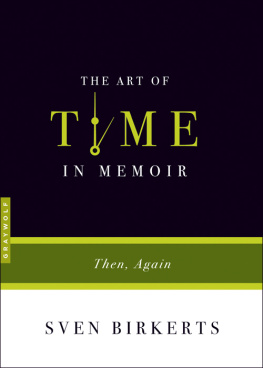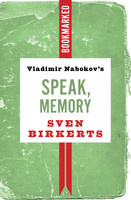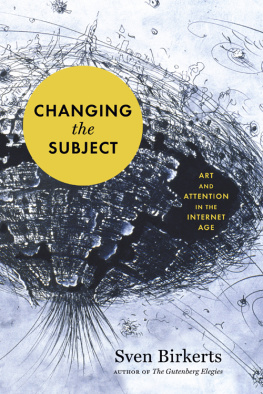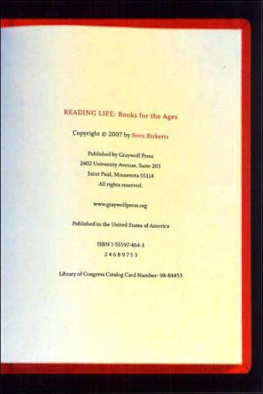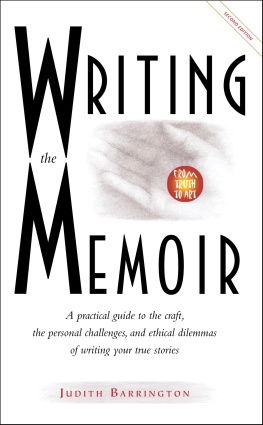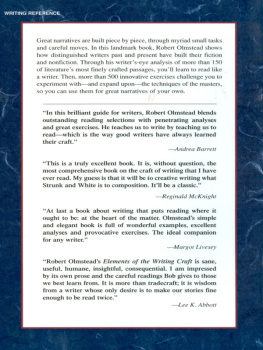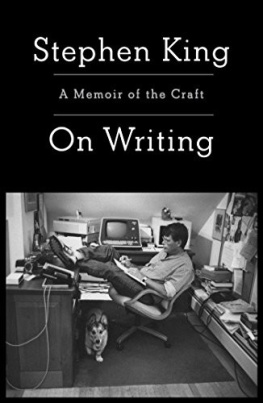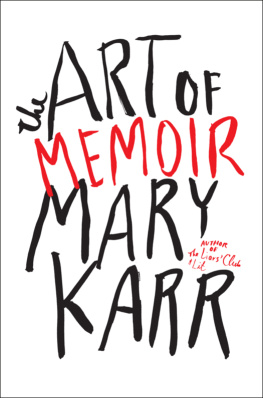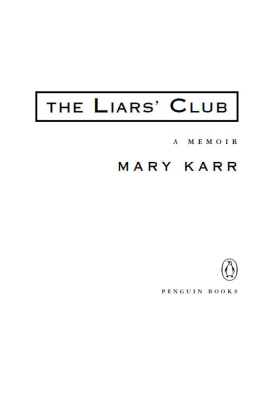The Art of SERIES
EDITED BY CHARLES BAXTER
The Art of series is a line of books reinvigorating the practice of craft and criticism. Each book is a brief, witty, and useful exploration of fiction, nonfiction, or poetry by a writer impassioned by a singular craft issue. The Art of volumes provide a series of sustained examinations of key, but sometimes neglected, aspects of creative writing by some of contemporary literatures finest practitioners.
The Art of Subtext: Beyond Plot by Charles Baxter
The Art of Time in Memoir: Then, Again by Sven Birkerts
The Art of Intimacy: The Space Between by Stacey DErasmo
The Art of Description: World into Word by Mark Doty
The Art of the Poetic Line by James Longenbach
The Art of Daring: Risk, Restlessness, Imagination by Carl Phillips
The Art of Attention: A Poets Eye by Donald Revell
The Art of Time in Fiction: As Long As It Takes by Joan Silber
The Art of Syntax: Rhythm of Thought, Rhythm of Song by Ellen Bryant Voigt
The Art of Recklessness: Poetry as Assertive Force and Contradiction by Dean Young
THE ART OF
TIME IN MEMOIR
THEN, AGAIN

Other Books by Sven Birkerts
The Other Walk
Reading Life: Books for the Ages
My Sky Blue Trades: Growing Up Counter in a Contrary Time
Readings
The Gutenberg Elegies: The Fate of Reading in an Electronic Age
American Energies: Essays on Fiction
The Electric Life: Essays on Modern Poetry
An Artificial Wilderness: Essays on Twentieth-Century Literature
EDITOR:
Tolstoys Dictaphone: Technology and the Muse
The Evolving Canon
Writing Well , with Donald Hall
The Art of
TIME IN MEMOIR
THEN, AGAIN
Sven Birkerts
Graywolf Press
Copyright 2008 by Sven Birkerts
Publication of this volume is made possible in part by a grant provided by the Minnesota State Arts Board, through an appropriation by the Minnesota State Legislature; a grant from the Wells Fargo Foundation Minnesota; and a grant from the National Endowment for the Arts, which believes that a great nation deserves great art. Significant support has also been provided by the Bush Foundation; Target; the McKnight Foundation; and other generous contributions from foundations, corporations, and individuals. To these organizations and individuals we offer our heartfelt thanks.

Clara Ueland and Walt McCarthy are pleased to support the Graywolf Press Art of series in honor of Brenda Ueland.
Published by Graywolf Press
250 Third Avenue North, Suite 600
Minneapolis, Minnesota 55401
All rights reserved.
www.graywolfpress.org
Published in the United States of America
ISBN 978-1-55597-489-3
Ebook ISBN 978-1-55597-339-1
4 6 8 9 7 5
Library of Congress Control Number: 2007924774
Series cover design: Scott Sorenson
Cover art: Scott Sorenson
Life is not what one lived, but what one remembers and how one remembers it in order to recount it.
Gabriel Garca Mrquez
THE ART OF
TIME IN MEMOIR
THEN, AGAIN
The Time of Our Lives
If I had a dollar for every time some writer or student or chance acquaintance has confided to me their desire to write a memoir, I could buy myself a mossy castle in the west of Ireland and disappear once and for all into my private mythology. Theres no getting around it: where we find the sense-making itchthe urge to capture and memorialize personal experiencethere we find the scratching of pens. Or, far more likely, the chattering of keys. Memoir is, for better and often for worse, the genre of our times, and I have now read and worked with enough would-be memoirists to recognize the force of the need as well as some of the obstacles to its artistic realization. Again and again people say to me, If I could just tell it, and I know exactly what they mean. But how hard it is to disabuse them of the idea that if they just started at the beginning and worked their way forward, all would be revealed. Wrong, wrong, wrong. There is in fact no faster way to smother the core meaning of a life, its elusive threads and connections, than with the heavy blanket of narrated event. Even the juiciest scandals and revelations topple before the drone of, And then and then
Memoir begins not with event but with the intuition of meaningwith the mysterious fact that life can sometimes step free from the chaos of contingency and become story. There is no telling whenor ifthe transformation will come, and I am wary about universalizing. What reflections I offer are based on my own experience and necessarily provisional.
A curious thing happened to me personally and as a writerI do make some slight distinctionwhen I entered my late forties, that time zone I reluctantly acknowledge as marking the onset of middle age. Quite suddenly, at least in retrospect, my relation to my own past changed. How can I describe it? It was as if that past, especially the events and feelings of my younger years, had taken a half step back, had overnight, following no effort on my part, arranged themselves into a perspective. No, perspective isnt quite right, for that suggests a fixed, even static arrangement. Rather, these materials had, without losing their animation or their savor, become available to me. They were there to be looked at and handled without as much of the usual emotional murkiness, with fewer complicating regrets, sadnesses, and so on.
More interesting still, those earlier yearsfrom early childhood to the time of my late twentiesoffered themselves to me as a mystery. I dont mean that there were crimes, literal or figurative, to get to the bottom of, only that behind the chronological accumulation of happenings, of this following that year after year, I discerned the possibility of hidden patterns, patterns that, if unearthed and understood, would somehow explain memy lifeto myself. These memories presented themselves discontinuously, as found bits of evidence, and I often felt, as they arrived, that they were trying to tell me something. I was possessed by the stuff of my own life, and on the strength of this I undertookat first hesitantly, later with grim resolutionto write about those years of formation. A memoir had announced itselfthough it was some time before I dared to apply that loaded term to what I was writing.
Why did this all happen when I was forty-eight and not when I was forty-five? What had changed in my psychic mix? I wish I knew. Or maybe I dont, for my inability to answer leaves a certain enigma intact at the heart of the enterprise. All I know is that there came a point in my life when the memories and feelings started coming in loud and clear. It was as if cause and effect had fallen into some new alignment. Things fit, but not so much side by side as associatively, in unforeseen orderings. I began to see that events and circumstances were not as contained as I had once thought, but were, rather, part of a complicated weave, their influence appearing and disappearing over long stretches. And with this came a changed understanding about time, that it was not, psychologically, a linear continuumthe whole business was much closer to four-dimensional chess, but even that is a simplification, for life contains four-dimensional chess and a good deal else.
As for trying to write about it, clearly 4-D chess would be an impossible model to try to follow. The best default seemed to be a work comprising at least two time linespresent and past. The now and the then (the many thens ), for it is the juxtaposition of the twoin whatever configurationthat creates the quasi-spatial illusion most approximating the sensations of lived experience, of recollection merging into the ongoing business of living.
Next page
